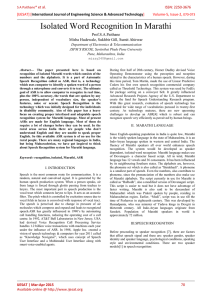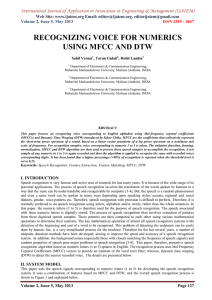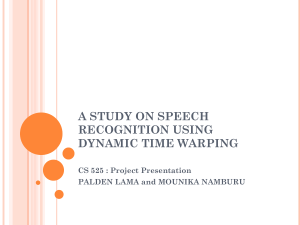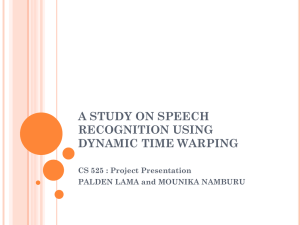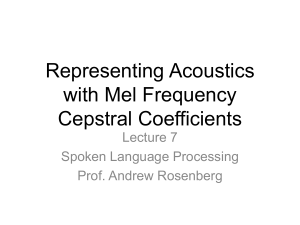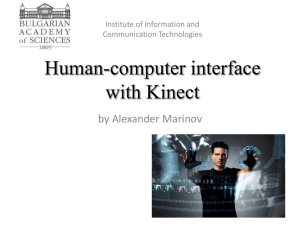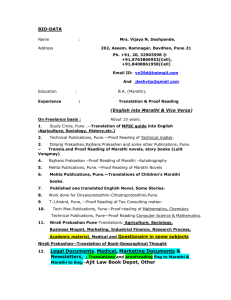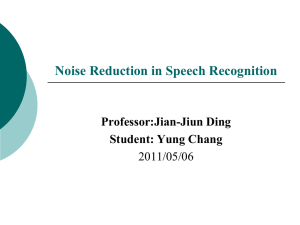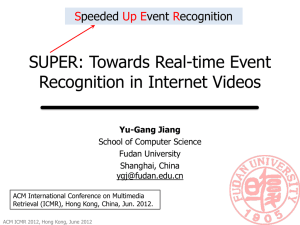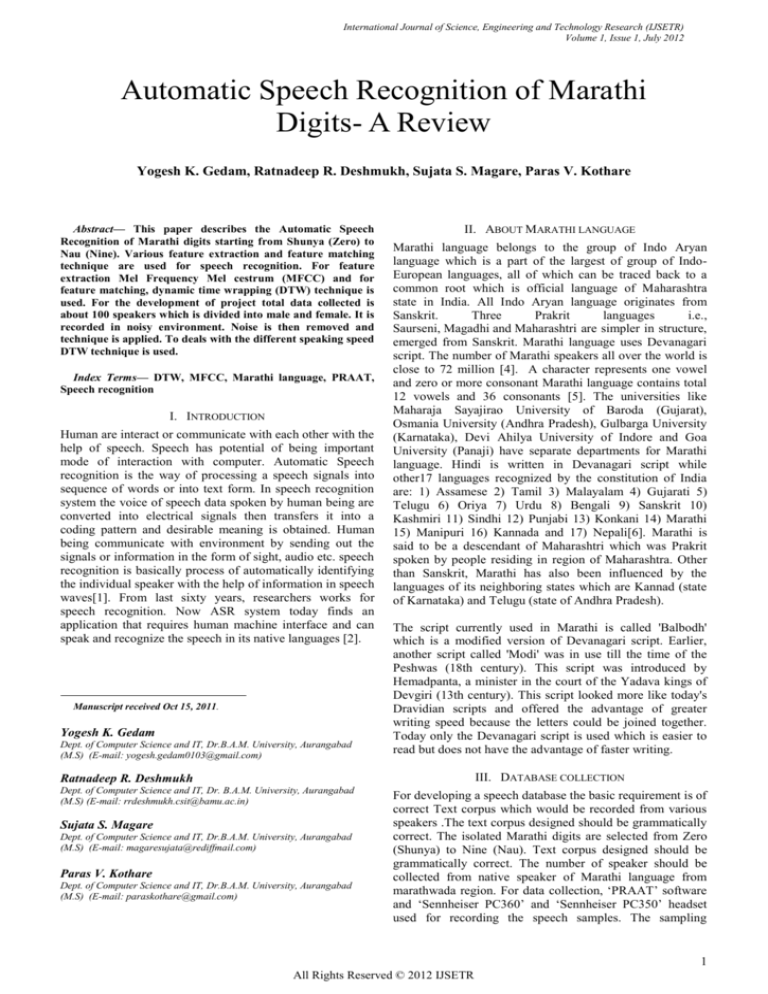
International Journal of Science, Engineering and Technology Research (IJSETR)
Volume 1, Issue 1, July 2012
Automatic Speech Recognition of Marathi
Digits- A Review
Yogesh K. Gedam, Ratnadeep R. Deshmukh, Sujata S. Magare, Paras V. Kothare
Abstract— This paper describes the Automatic Speech
Recognition of Marathi digits starting from Shunya (Zero) to
Nau (Nine). Various feature extraction and feature matching
technique are used for speech recognition. For feature
extraction Mel Frequency Mel cestrum (MFCC) and for
feature matching, dynamic time wrapping (DTW) technique is
used. For the development of project total data collected is
about 100 speakers which is divided into male and female. It is
recorded in noisy environment. Noise is then removed and
technique is applied. To deals with the different speaking speed
DTW technique is used.
Index Terms— DTW, MFCC, Marathi language, PRAAT,
Speech recognition
I. INTRODUCTION
Human are interact or communicate with each other with the
help of speech. Speech has potential of being important
mode of interaction with computer. Automatic Speech
recognition is the way of processing a speech signals into
sequence of words or into text form. In speech recognition
system the voice of speech data spoken by human being are
converted into electrical signals then transfers it into a
coding pattern and desirable meaning is obtained. Human
being communicate with environment by sending out the
signals or information in the form of sight, audio etc. speech
recognition is basically process of automatically identifying
the individual speaker with the help of information in speech
waves[1]. From last sixty years, researchers works for
speech recognition. Now ASR system today finds an
application that requires human machine interface and can
speak and recognize the speech in its native languages [2].
Manuscript received Oct 15, 2011.
Yogesh K. Gedam
Dept. of Computer Science and IT, Dr.B.A.M. University, Aurangabad
(M.S) (E-mail: yogesh.gedam0103@gmail.com)
II. ABOUT MARATHI LANGUAGE
Marathi language belongs to the group of Indo Aryan
language which is a part of the largest of group of IndoEuropean languages, all of which can be traced back to a
common root which is official language of Maharashtra
state in India. All Indo Aryan language originates from
Sanskrit.
Three
Prakrit
languages
i.e.,
Saurseni, Magadhi and Maharashtri are simpler in structure,
emerged from Sanskrit. Marathi language uses Devanagari
script. The number of Marathi speakers all over the world is
close to 72 million [4]. A character represents one vowel
and zero or more consonant Marathi language contains total
12 vowels and 36 consonants [5]. The universities like
Maharaja Sayajirao University of Baroda (Gujarat),
Osmania University (Andhra Pradesh), Gulbarga University
(Karnataka), Devi Ahilya University of Indore and Goa
University (Panaji) have separate departments for Marathi
language. Hindi is written in Devanagari script while
other17 languages recognized by the constitution of India
are: 1) Assamese 2) Tamil 3) Malayalam 4) Gujarati 5)
Telugu 6) Oriya 7) Urdu 8) Bengali 9) Sanskrit 10)
Kashmiri 11) Sindhi 12) Punjabi 13) Konkani 14) Marathi
15) Manipuri 16) Kannada and 17) Nepali[6]. Marathi is
said to be a descendant of Maharashtri which was Prakrit
spoken by people residing in region of Maharashtra. Other
than Sanskrit, Marathi has also been influenced by the
languages of its neighboring states which are Kannad (state
of Karnataka) and Telugu (state of Andhra Pradesh).
The script currently used in Marathi is called 'Balbodh'
which is a modified version of Devanagari script. Earlier,
another script called 'Modi' was in use till the time of the
Peshwas (18th century). This script was introduced by
Hemadpanta, a minister in the court of the Yadava kings of
Devgiri (13th century). This script looked more like today's
Dravidian scripts and offered the advantage of greater
writing speed because the letters could be joined together.
Today only the Devanagari script is used which is easier to
read but does not have the advantage of faster writing.
III. DATABASE COLLECTION
Ratnadeep R. Deshmukh
Dept. of Computer Science and IT, Dr. B.A.M. University, Aurangabad
(M.S) (E-mail: rrdeshmukh.csit@bamu.ac.in)
Sujata S. Magare
Dept. of Computer Science and IT, Dr.B.A.M. University, Aurangabad
(M.S) (E-mail: magaresujata@rediffmail.com)
Paras V. Kothare
Dept. of Computer Science and IT, Dr.B.A.M. University, Aurangabad
(M.S) (E-mail: paraskothare@gmail.com)
For developing a speech database the basic requirement is of
correct Text corpus which would be recorded from various
speakers .The text corpus designed should be grammatically
correct. The isolated Marathi digits are selected from Zero
(Shunya) to Nine (Nau). Text corpus designed should be
grammatically correct. The number of speaker should be
collected from native speaker of Marathi language from
marathwada region. For data collection, ‘PRAAT’ software
and ‘Sennheiser PC360’ and ‘Sennheiser PC350’ headset
used for recording the speech samples. The sampling
1
All Rights Reserved © 2012 IJSETR
International Journal of Science, Engineering and Technology Research (IJSETR)
Volume 1, Issue 1, July 2012
frequency was set to 24000 Hz with Mono sound type and
the recorded sample was saved as ‘.wav’ file.
The PC360 and PC350 headsets are having noise
cancellation facility and the signal to noise ratio (SNR) is
less. PRAAT is a very flexible tool to do speech analysis. It
offers a wide range of standard and non-standard
procedures, including spectrographic analysis, articulator
synthesis, and neural networks [7].Number of speakers
selected are 100. The selected speakers were 50 males and
50 females. Each speaker is asked to speak the numbers
Shunya (zero) up to Nau (nine) i.e. ten numbers with three
utterances of each number. Total data collected is about
3000.The data collected is divided into male and female
speakers.
IV. APPROACHES TO SPEECH RECOGNITION
It contains following approaches
Acoustic Phonetic Approach
Pattern Recognition Approach
Knowledge Based Approach
Connectionist Approach
Support Vector Machine (SVM)
Dynamic Time Warping (DTW)
Vector Quantization (VQ)
Support Vector Machine (SVM)
Support Vector Machines were first introduced by Vapnik
[12]. It represents a new approach to pattern classification. It
has great ability to generalized often resulting in better
performance than traditional technique like Artificial Neural
Network (ANN). Support vector machine can be used as a
regularized radial basis function classifier.
Dynamic Time Warping (DTW)
It is introduced in speech recognition area by Sakoe and
Chiba in 1971. Dynamic time warping is an algorithm for
measuring similarity between two sequences which may
vary in time or speed. DTW is a method that allows a
computer to find an optimal match between two given
sequences (e.g. time series) with certain restrictions [12].
Vector Quantization (VQ)
In Vector quantization process, mapping of vectors is done
from a large vector space to a finite number of regions in
that space known as cluster and each region is represented
by its center known as code word. Each code word is
collected together and forms a codebook. Hence each cluster
or centroid represents a different class of speech signals
which is the data significantly compressed, yet still
accurately represented [13].
V. PROPOSED APPROACH
Acoustic phonetic approaches
It is basically depends upon theory of acoustic phonetics and
postulate [8]. The basis of acoustic phonetic approach is
basically on finding the speech sound and providing
appropriate labels to it (Hemdal and Hughes 1967). It also
postulates that there exist finite, distinctive phonetic units in
spoken language. These units are broadly characterized by a
set of acoustic properties.
Pattern Recognition Approach
It involves two essential steps namely pattern training and
pattern comparison [9] [10] [11]. It uses well formulated
mathematical framework and established consistent speech
pattern representation from set of labeled training samples
via formal training algorithm. Speech pattern recognition
can be in the form of speech template o statistical model
(HMM) and can be applied to a sound, a word, a phrase etc.
Knowledge Based Approach
Artificial intelligence approach a hybrid of the acoustic
phonetic approach and pattern recognition approach and it
attempts to mechanize the recognition procedure according
to way of person applies intelligence in visualizing and
characterizing speech based on a set of measured acoustic
features. Knowledge based approach uses the information
regarding linguistic, phonetic and spectrogram
Connectionist Approach (Artificial Neural Networks)
The artificial intelligence approach (Lesser et al. 1975;
Lippmann 1987) attempts to mechanize the recognition
procedure according to the way a person
applies
intelligence in visualizing, analyzing, and characterizing
speech based on a set of measured acoustic features.
This paper is used to recognize the Marathi digits from
different speakers starting from Shunya (zero) to Nau (nine).
For speech recognition, feature extraction (MFCC), feature
matching technique (DTW) is used.
Feature Extraction
Feature extraction technique is process of removing
redundant and unwanted information from the speech
signals and retaining only useful information [14].
Sometimes, important data may be loss, while removing
unwanted information. It involves analysis of the speech
signals [15] and may involve transforming the signal into a
form appropriate for the models used for classification. The
most commonly used features in speech nowadays are the
Mel Frequency Cepstral Coefficients (MFCC), in which the
frequency bands are positioned logarithmically along the
Mel scale, and the Perceptual Linear Predictive (PLP), in
which the bark scale and an all-pole model is used[16][17].
Mel Frequency Coefficient Ceptrum (MFCC)
MFCC is based on human peripheral auditory system and
cannot perceive frequencies over 1KHz. MFCC are based on
the short-term analysis, and thus a MFCC vector is
computed from each frame. MFCC have two types of filter
which are spaced at low frequency below 1000 Hz linearly
and logarithmic spacing above 1000 Hz. As reference point,
Pitch of 1 KHz tone, above 40 dB the perceptual hearing
threshold is defined as 1000 Mels [18].
A. Preprocessing
Speech signals are normally preprocessed before feature
extraction to enhance the accuracy and efficiency of feature
extraction. Speech signal in the form of wave has suffer
2
All Rights Reserved © 2012 IJSETR
International Journal of Science, Engineering and Technology Research (IJSETR)
Volume 1, Issue 1, July 2012
from noise hence it is necessary to remove it. Hence to
reduce spectrally flatten speech signal, preemphasis is
applied. It uses first order high pass FIR filter to
preemphasize the higher frequency component.
peaks for the filter banks. Equation as shown in “(3)” is used
to compute the Mel for given frequency f in Hz.
𝐹(𝑚𝑒𝑙) = 2595 ∗ log 10 (1 +
E.
Fig 1: Steps for MFCC technique
B. Framing and windowing
To analyze a signal at one time is difficult task; hence
speech signal is split into frames of size range 0-20 ms in
time domain and analyses in short time. After that
overlapping is applied to it because on each individual
frame, hamming window is applied. In speech recognition,
the most commonly used window shape is the hamming
window shown in “(1)”.
Hamming window:
𝑤(𝑛) = 0.54 − 0.46 cos (
2𝜋𝑛
)
𝐿−1
0 ≥𝑛 ≥ 𝐿−1
𝑓
700
)
……. (3)
Discrete Cosine Transform
It express the finite sequence of the data points in terms of
sum of cosine function oscillating with different
frequencies. It converts the log Mel spectrum into time
domain and results into Mel Frequency Cepstral Coefficient
and set is called as acoustic vectors. The Cepstral
representation of the speech spectrum provides a good
representation of the local spectral properties of the signal
for the given frame analysis [21]. Because the mel spectrum
coefficients (and so their logarithm) are real numbers, we
can convert them to the time domain using the Discrete
Cosine Transform (DCT).
F. Delta Energy and Delta Spectrum
The voice signal and the frames changes, so there is a need
to add features related to the change in Cepstral features
over time. The energy in a frame for a signal x in a window
from time sample t1 to time sample t2, is represented as
shown below in “(4)” here x[t] is signal,
𝐸𝑛𝑒𝑟𝑔𝑦 = ∑ 𝑥 2 [𝑡]
……. (4)
Feature Matching
0
𝑜𝑡ℎ𝑒𝑟𝑤𝑖𝑠𝑒
…… (1)
Hamming window gets rid of some of the information at the
beginning and end of each frame .To avoid the risk of losing
the information from the speech signal, the frame is shifted
10 ms so that the overlapping between two adjacent frames
is 50%. The windowing function is applied after dividing
the signal into frames that contain nearly stationary signal
blocks [19].
C. Fourier Transform
DFT is used to convert each frame of N samples from time
domain to frequency domain. To obtain a good frequency
resolution, a 512 point Fast Fourier Transform (FFT) is
used. It is used to convert the convolution of glottal pulse
and vocal track in time domain into frequency domain.
𝜇
−𝑗2𝑘𝑛
𝑛
X[k] = ∑𝑁−1
𝑛=0 𝑥[𝑛]𝑒
There are many feature-matching techniques used in speaker
recognition such as Dynamic Time Warping (DTW),
Hidden Markov Modeling (HMM), and Vector
Quantization.
A. Dynamic Time Warping
This algorithm is based on dynamic programming and used
for measuring the similarity between two time series which
may vary in time. This technique also used to find the
optimal alignment between two times series if one time
series may be “warped” non-linearly by stretching or
shrinking it along its time axis. This warping can then be
used to find corresponding regions between the two time
series or to determine the similarity between the two time
series. It also aims at aligning two sequences of feature
vectors by warping the time axis repetitively until an
optimal match between the two sequences is found.
……. (2)
Spectral analysis signifies that different timber in speech
signals corresponds to different energy distribution over
frequencies. So FFT is executing to obtain magnitude
frequency response of each frame. It also prepares the signal
for next stage [20].
D. Mel-Frequency Filter Bank
A filter bank is created by calculating a number of peaks,
uniformly spaced in the Mel-scale and then transforming the
back to the normal frequency scale where they are used a
Fig 2: Time Alignment of two time independent sequences
For given an n- by- m matrix where the (𝑖 𝑡ℎ ,𝑗𝑡ℎ ) element of
the matrix contains the distance 𝑑(𝑞𝑖 , 𝑐𝑗 ) between the two
points 𝑞𝑖 𝑎𝑛𝑑 𝑐𝑗 is constructed .The absolute distance
between the values of two sequences is calculated using the
Euclidean distance shown in “(5)”.
3
All Rights Reserved © 2012 IJSETR
International Journal of Science, Engineering and Technology Research (IJSETR)
Volume 1, Issue 1, July 2012
𝑑(𝑞𝑖 , 𝑐𝑗 ) = (𝑞𝑖 − 𝑐𝑗 )2
……. (5)
Each matrix element (i, j) corresponds to the alignment
between the points and then, accumulated distance is
measured by shown by “(6)”
.
𝐷(𝑖, 𝑗) = min [𝐷(𝑖 − 1, 𝑗 − 1), 𝐷(𝑖 − 1, 𝑗), 𝐷(𝑖, 𝑗 − 1)]
+ 𝐷(𝑖, 𝑗)
……. (6)
VI. ANALYSIS FROM THE REVIEW
In this paper we describe the feature extraction technique i.e.
MFCC for speech recognition and its analysis. First the
speech data will be collected from the native speakers of
Marathi Language. The selected speakers where from
different geographical region of Marathwada region of
Maharashtra state. The speakers were comfortable with
reading and speaking the Marathi Language. The speakers
are classified on the basis of gender and were in between the
age group of 18 to 30 years. The selected speakers were 50
males and 50 females.
Speech recognition system contains feature extraction and
feature matching. Feature extraction technique removes the
noise and unnecessary information from the speech signals
and recognized the pattern. Feature matching technique it
approximate the general extension of the classes within the
feature space from training set. Mel-Frequency Cepstral
Coefficients (MFCC) is one amongst the most normally
used feature extraction methodology in speech recognition.
The use of Mel-Frequency Cepstral Coefficients can be
considered as one of the standard method for feature
extraction.
CONCLUSION AND FUTURE WORK
The main aim of our project is to recognize isolated speech
using MFCC and DTW techniques. In this paper we
describe the speech recognition of Marathi digits using
MFCC and DTW technique. In MFCC, the main advantage
is that it uses Mel-frequency scaling which is very
approximate to the human auditory system. Feature
matching was done with the help of Dynamic Time Warping
(DTW). DTW is the best nonlinear feature matching
technique in speech identification, with minimal error rates
and fast computing speed. Many problems is arise during
the data collection for approaching the peoples to data
recording. Further work is done for increasing the accuracy
and also performance of speech recognition for Marathi
digits.
ACKNOWLEDGMENTS
The authors would like to thank the University Authorities
for providing the infrastructure to carry out the research.
This work is supported by University Grants Commission
Engineering and Technology Research (IJSETR),Volume 1,
Issue 6, December 2012
[2] Omprakash Prabhakar, Navneet Kumar Sahu, “A Survey
On: Voice Command Recognition Technique”, International
Journal of Advanced Research in Computer Science and
Software Engineering, Volume 3, Issue 5, May 2013
[3] K. Samudravijaya, “Multilingual Telephony Speech
Corpora of Indian Languages”, In Proceeding Computer
Processing of Asian Spoken Languages. Eds, S. Itahashi
Ans C. Tseng, Consideration Books Los Angeles, pp.189193, 2010
[4] Agrawal S. S., K. K. Arora, S. Arora, Samudravijaya K,
“Text and Speech Corpus Development in Indian
Languages”, ibid, pp. 94-97.
[5] Santosh K. Gaikwad, Bharti W. Gawali, Pravin
Yannawar, “A Review on Speech Recognition Technique”,
International Journal of Computer Applications (0975 –
887).Volume 10– No.3, Nov 2010
[6] Gopalakrishna Anumanchipalli, Rahul Chitturi, Sachin
Joshi, Rohit Kumar, Satinder Pal Singh, R. N. V. Sitaram, S.
P Kishore, “Development of Indian Language Speech
Databases for Large Vocabulary Speech Recognition
Systems”.
[7] PRAAT Software
Source: http://www.fon.hum.uva.nl/praat, cited on
03/08/2013
[8] IBM (2010) online IBM Research
Source: http://www.research.ibm.com, cited on 07/12/2013.
[9] F. Itakura, “Minimum Prediction Residula Applied to
Speech Recognition”, IEEE Transaction on Acoustics,
Speech, Signal Proc., ASSP-23(1):67-72, February 1975.
[10] L. R. Rabiner, “A Tutorial on Hidden Markov Models
and Selected Applications in Speech Recognition”, Proc.
IEEE, 77 (2):257-286, February 1989.
[11] L. R. Rabiner, “Fundamentals of Speech Recognition”,
Prentice Hall, Englewood (1993).
[12] Cory S. Myers, D Lawrence R. Rabiner,”A Level
Building Dynamic Time Warping Algorithm For Connected
Word Recognition”, IEEE Transactions on Acoustics,
Speech and Signal Processing, Vol. Assp-29, No. 2, April
1981
[13] Anjali Jain, O.P. Sharma, “A Vector Quantization
Approach for Voice Recognition Using Mel Frequency
Cepstral Coefficient (MFCC): A Review”, IJECT Vol. 4,
Issue Spl - 4, April - June 2013, ISSN: 2230-7109 (Online) |
ISSN: 2230-9543 (Print)
REFERENCES
[1] Priyanka Mishra, Suyash Agrawal, “Recognition of
Speaker Using Mel Frequency Cepstral Coefficient &
Vector Quantization”, International Journal of Science,
[14] Bhupinder Singh, Rupinder Kaur, Nidhi Devgun,
Ramandeep Kaur, ‘The process of Feature extraction in
Automatic Speech Recognition System for Computer
Machine Interaction with Humans: A Review’, International
Journal of Advanced Research in Computer Science and
4
All Rights Reserved © 2012 IJSETR
International Journal of Science, Engineering and Technology Research (IJSETR)
Volume 1, Issue 1, July 2012
Software Engineering , ISSN: 2277 128X , Volume 2, Issue
2, February 2012
[15] Stolcke A., Shriberg E., Ferrer L., Kajarekar S.,
Sonmez K., Tur G. (2007),“ Speech Recognition As Feature
Extraction For Speaker Recognition” SAFE, Washington
D.C., USA pp 11-13.
[16] Zheng Fang, Zhang Guoliang, Song Zhanjiang,
“Comparison of Different Implementations of MFCC”,
Journal of Computer Sci. Technology., 16(6):582–589, 2001
[17] H. Hermansky, “Perceptual Linear Predictive (PLP)
Analysis of Speech”, J. Acoustic. Soc. America, 87, 1990
[18] Maruti Limkar, Rama Rao, Vidya Sagvekar, “Isolated
Digit Recognition Using MFCC AND DTW”, International
Journal on Advanced Electrical and Electronics
Engineering, (IJAEEE), ISSN (Print): 2278-8948, Volume1, Issue-1, 2012
[19] Siddheshwar S. Gangonda, Dr. Prachi Mukherji,
“Speech Processing for Marathi Numeral Recognition using
MFCC and DTW Features”, International Journal of
Engineering Research and Applications (IJERA) ISSN:
2248-9622
[20] Shivanker Dev Dhingra , Geeta Nijhawan , Poonam
Pandit, “Isolated Speech Recognition Using MFCC and
DTW”, International Journal of Advanced Research in
Electrical,Electronics and Instrumentation Engineering, Vol.
2, Issue 8, August 2013
[21] “MFCC and Its Applications in Speaker Recognition”
Vibha Tiwari, Deptt. of Electronics Engg., Gyan Ganga
Institute of Technology and Management, Bhopal, (MP)
INDIA (Received 5 Nov., 2009, Accepted 10 Feb., 2010).
[22] Anjali Bala, Abhijeet Kumar, Nidhika Birla, “Voice
Command Recognition System Based on MFCC and
DTW”, International Journal of Engineering Science and
Technology Vol. 2 (12), 2010, 7335-7342.
5
All Rights Reserved © 2012 IJSETR

